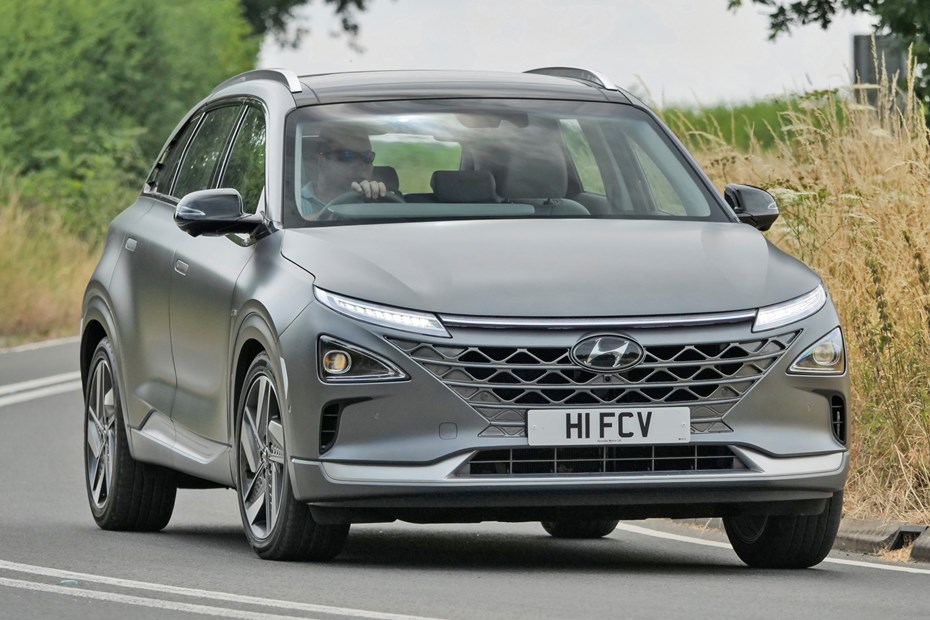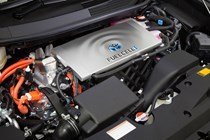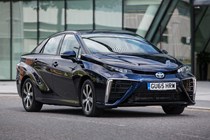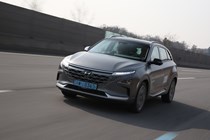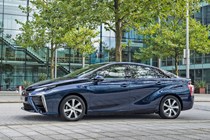A hydrogen car uses hydrogen instead of petrol or diesel for fuel. As one of the most abundant elements in the world, hydrogen is considered a potential solution to more eco-friendly motoring, as in some cases the only emissions in motion are water vapour. Meanwhile, refuelling is much quicker than recharging a battery electric vehicle such as a Tesla.
However, the technology required to make hydrogen suitable as a fuel for cars and other vehicles is expensive, and a new hydrogen filling station network would need to be established in order for it to be viable. So as electric cars become more and more capable, hydrogen seems less and less likely to become a widespread alternative – although some manufacturers do now have hydrogen cars for sale.
How do hydrogen cars work?
There are two main types of hydrogen car technology.
Most carmakers are pursuing hydrogen fuel cell technology. This creates a chemical reaction within the fuel cell that turns hydrogen into electricity. The exact details of how this works are in the FAQ section below, but it essentially means the fuel cell functions in the same way as an conventional electric car’s battery. Except that you pump hydrogen in and get water vapour out.
For this reason, such cars are known as hydrogen fuel cell electric vehicles: HFCEV or even just FCEV. Less commonly, they are sometimes hydrogen electric vehicle (HEV).
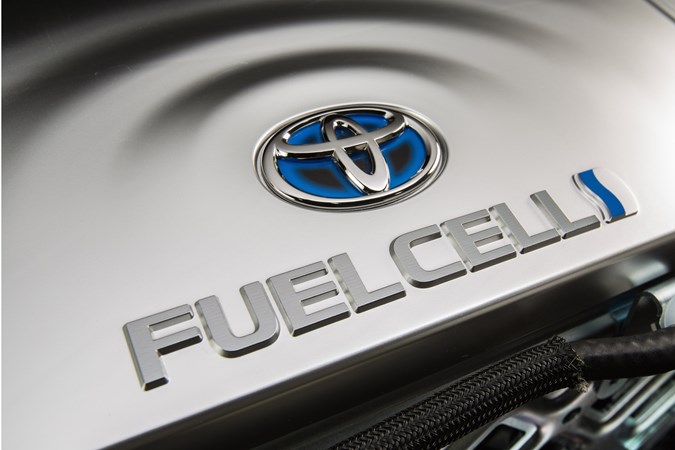
Hydrogen can also be used as a fuel for internal combustion – similar to petrol or diesel.
Both forms of hydrogen tech can also be found combined with plug-in hybrid technology; a recent example of this being the Stellantis hydrogen vans that are presently available to buy in Europe.
What are the advantages to hydrogen cars?
As well as being potentially very clean and green – it’s no joke about the only emissions being water vapour, and the abundance of hydrogen itself means there’s plenty of it available – refuelling a hydrogen car takes a matter of minutes. Usually between three and seven, depending on the pressure of the supply and the size of the tanks.
This has always led forward-thinkers to suggest that hydrogen would become a more suitable solution for long-distance travel than battery-powered electric cars, which typically have shorter ranges driving and much longer charging times.
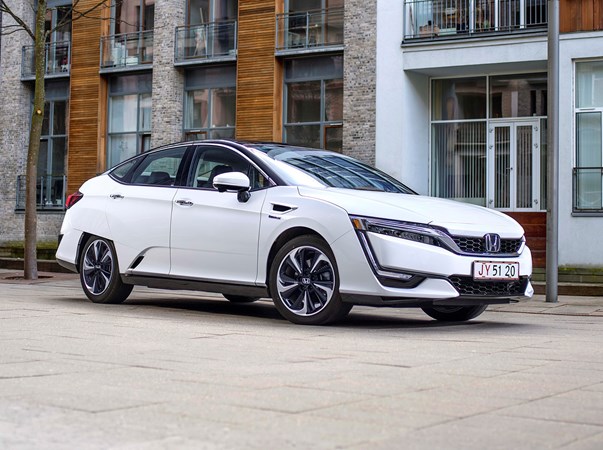
A full tank of hydrogen could enable motorists to drive up to 500 miles before needing to refuel. This in turn means less of a lifestyle shift for drivers, especially those who can’t easily access a charge point, whether at home or using the public charging network.
However, as battery electric vehicles (BEVs) become more advanced, charging gets faster and driving ranges increase, the need for a secondary long-range technology such as hydrogen reduces.
What are the disadvantages of hydrogen cars?
The fundamental problem with hydrogen as a fuel for cars is that it’s expensive.
Fuel cells are quite simple in concept but pricey to construct – they often feature platinum, one of the top five most expensive metals to mine (but then, so do the catalytic converters on the car you’ve probably got outside) – and typically aren’t that energy efficient for the amount of space they take up.
Efficiency is also an issue for cars that use hydrogen for combustion – you don’t get as much energy as you do from an equivalent petrol and diesel engines. Though this is surely in part due to how highly developed these legacy fuels are at this stage.
Hydrogen itself certainly is plentiful, but it’s often combined with other elements – such as oxygen, creating water – and it takes a lot of power to separate (‘electrolyse’) it. This damages its green credentials as well as costing lots.
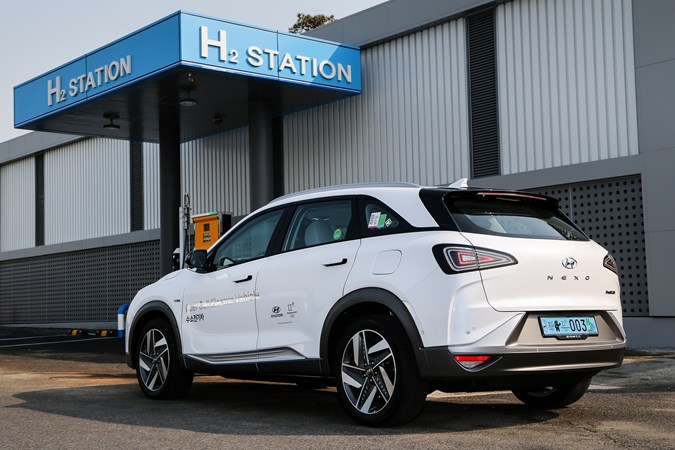
So while it’s possible to build hydrogen refuelling stations that create the hydrogen on site, doing so is – you guessed it – expensive. The alternative is to use tankers to deliver the hydrogen, just as petrol and diesel is delivered to your current local filling station, but this also impacts how green hydrogen is actually able to be.
Whichever way you want to do it, many, many more hydrogen filling stations would need to be created (there are presently just 15 in the UK), which is further logistical and monetary expense – although also arguable similar to the situation faced by the public car charging network.
Hydrogen also has a bit of an image problem, which impacts other aspects that increase costs and make hydrogen cars more difficult.
Are hydrogen cars dangerous?
This is the image problem. Which historically relates to the 1937 Hindenburg disaster, a hydrogen-filled airship that exploded, killing 36 people. Rest assured that the technology has come on a long way since then.
To such an extent, in fact, that modern FCEVs are likely safer than their petrol or diesel counterparts. Refuelling systems perform checks and lock the pump into the car to prevent accidental spillages, and the cars themselves are packed with leak-detection sensors.
The safety experts at Euro NCAP have performed independent crash tests on the two currently available hydrogen cars, the Hyundai Nexo and Toyota Mirai. Both received five-stars (though the Hyundai’s result came in 2018, versus the Mirai’s 2021 score under tougher conditions).

And though hydrogen is stored at high-pressure – compressed to 350-700 bar, depending on the vehicle; your household boiler pressure is likely 1-2 bar – the tanks are designed to withstand this and more. They even undergo ballistics testing (being shot at, basically) and are crash-tested extensively.
No carmaker wants a ‘wheeled Hindenburg’ headline, after all. Much of the other hardware used is similar or the same as that in regular electric vehicles, so there’s little to worry about there. But packaging the tanks (there’s usually more than one) is another thing that engineers and designers have to think about.
What hydrogen cars can you buy in the UK?
If you are considering a brand new hydrogen car then you’ve got a choice of just two, detailed below.
Hyundai NEXO
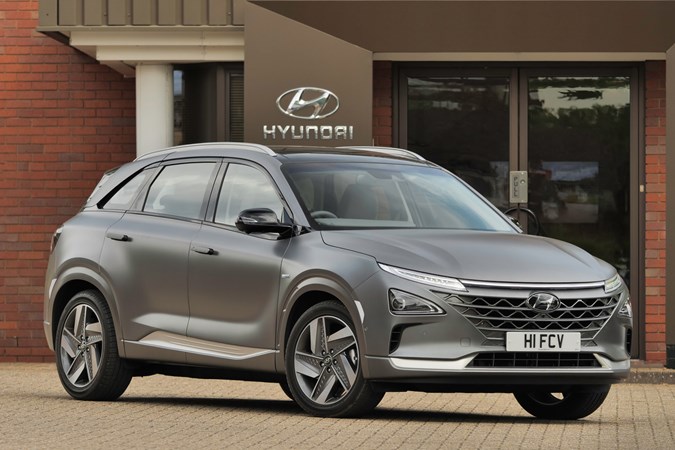
Building on the track record of its 1,000-strong pilot fleet of Hyundai ix35 Fuel Cell cars, the Hyundai Nexo is one of only two hydrogen fuel cell vehicles on the UK market at present – although in reality it’s limited to business customers only, with pricing around £70,000.
Because it generates the electricity it needs to propel the car on demand, the battery pack is just 1.6kWh, yet it can store enough compressed hydrogen to give it a driving range of 414 miles (WLTP). It’s an attractive-looking SUV and well-rounded to drive. But the price means it’s only ever going to attract the most green-minded of enthusiasts with a Berkshire or North Hampshire postcode (closest for refuelling stations).
Toyota Mirai
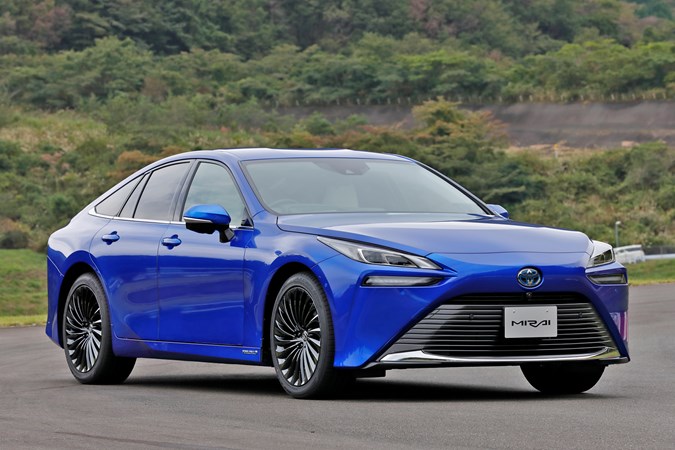
The Toyota Mirai was one of the first widely hydrogen fuel-cell cars, and is now on its second generation. This iteration is a far more elegant vehicle than the first-generation Mirai, with more passenger space and a range of approximately 400 miles between refills. With such little competition, its biggest challenge comes from the lack of infrastructure.
Nonetheless, it’s a comfy car to drive, with a stylish exterior and smooth, silent response. And of course, the Mirai emits nothing but water. For relatively well-healed early adopters, living in South East England (where most of the filling stations are), the Mirai is a genuine option, if Teslas really are a turn-off. Pricing starts at a more reasonable seeming £49,995.
Hydrogen car FAQs
How many hydrogen filling stations are there in the UK?
There are currently only 15 hydrogen refuelling stations (HRS) open to the public in the UK, with several of these located within the M25 motorway around London.
With the government-backed UK H2 Mobility project and British start-ups like Riversimple pledging to keep chipping away at the hydrogen dream, there may be a day when a key breakthrough will turn the tide and make hydrogen a more cost-effective solution. Until then, the choice of FCEVs is likely to remain limited.
What are hydrogen cars like to drive?
Hydrogen cars drive a lot like a battery electric vehicle: almost silently and with instant torque. They are smooth, refined and generally offer impressive performance where electric motors are used to drive the wheels.
Hydrogen combustion cars are more like conventional petrol and diesel vehicles, so there’s increased vibration and more noise. They aren’t usually as powerful or fast, either.
Will there be other hydrogen cars in the near future?
The Catch-22 issue for car makers is production of an FCEV isn’t cheap and the market is limited, as is the infrastructure. Most car companies are working both individually and collaboratively on hydrogen FCEV technology, with Honda and Mercedes-Benz already offering such vehicles for sale in selected markets – but not yet in the UK.
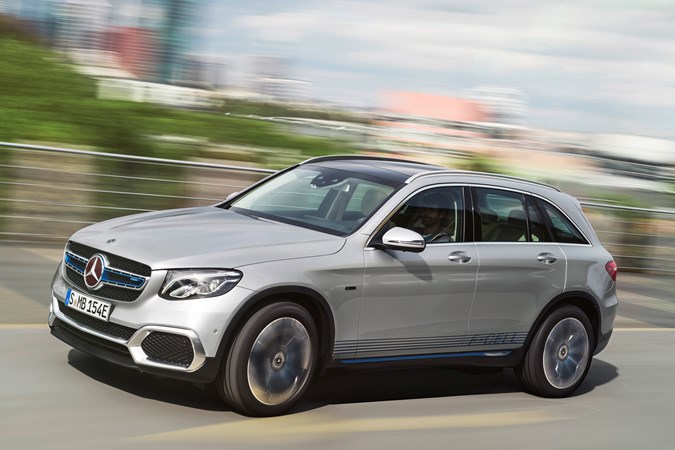
Expect to see a much greater number of battery electric vehicles go on sale before hydrogen models gain popularity.
Even when hydrogen vehicles are more readily available, the technology is likely to be limited to larger, more expensive cars, with smaller, cheaper models expected to remain as BEVs.
Hydrogen also suits large vehicles such as trucks and buses far better than a battery-only electric solution, meaning over the next decade the technology will be honed more quickly by long-distance real-world development.
Are hydrogen cars easy to refuel?
Yes, and the process is much more like refilling a petrol or diesel car, rather than the process to charge an electric car.
One key difference is that the hydrogen filler nozzle clamps to the car – if you have ever refilled an LPG-powered car, it’s a similar experience. This is a safety measure to prevent high-pressure, very cold hydrogen leaking during the refill.
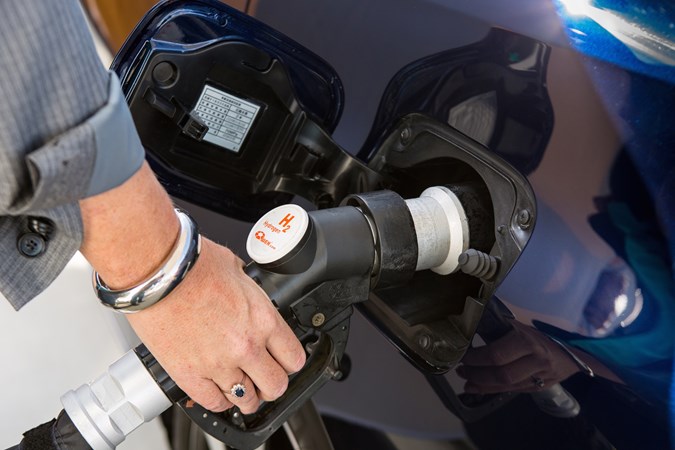
Once clamped on, the liquid hydrogen is pumped into the tank, pausing every so often to depressurise to ensure as much fuel as possible can be delivered.
When the display on the filling pump confirms it’s finished, simply unclamp the nozzle and return it to its holster.
How does a hydrogen fuel cell work?
The fuel cell in a hydrogen car acts a bit like a battery. Using an platinum catalyst, the hydrogen ‘anode’ is stripped of its positive electrons so the negative ones can move through the electrolyte to react with the oxygen ‘cathode’, emitting nothing but ‘water’.
Meanwhile, the party-loving positive electrons – better known as electricity – are sent off through the circuit, powering whatever device is connected. In this case, an electric motor propelling wheels on the axle of an electric vehicle.
Hydrogen vs electric cars
When hydrogen is used in a fuel cell, these two types of vehicle propulsion are very similar. In both cases, electricity is used to drive an electric motor that then drives the wheels. The driving experience is therefore very similar as well.
The difference is that hydrogen currently offers much faster refuelling and a longer driving range. But BEV technology has been catching up in recent years, and the electricity grid required to charge the batteries these rely on is already in place. In a way that the hydrogen refuelling infrastructure most certainly is not.
Battery technology is usually thought of as cheaper than fuel cell technology, too. But with the Toyota Mirai available for less than £50,000 and many even modest modern EVs costing close to or more than that, we’re not convinced that argument still holds water. Although the cost to Toyota to build a Mirai may well be higher than the retail price.
Do hydrogen cars represent the future of motoring?
They’re certainly not suitable for many buyers as things stand right now, simply because there aren’t many hydrogen filling stations in the UK. However, considering the massive benefits of this type of power generation compared with using fossil fuels – either in conventional combustion engines or to run the national grid – it’s likely we’ll see the infrastructure growing increasingly quickly during the 2020s.
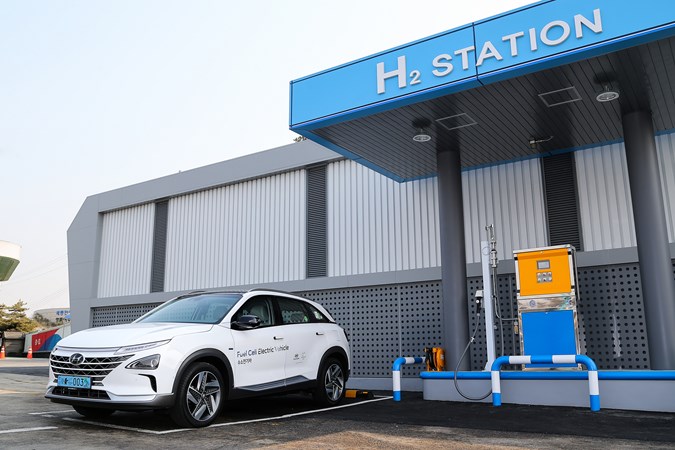
It’s going to rely heavily on investment, both from large multinational companies and governments, in order to grow at any pace, though. For that reason it’s likely we’ll see an increasing number of commercial vehicles powered by hydrogen first.
Will all cars eventually be hydrogen-powered?
This seems unlikely. While no-one knows exactly what’ll happen moving forwards, it’s likely that battery development could outstrip the pace of scaling cost-effective fuel cell technology development. If a battery can store enough for most drivers’ usage on its own, then perhaps we wouldn’t need the fuel cell at all.
That said, hydrogen may prove useful for HGVs and other freight vehicles. What’s clear is that for short-range work, such as inner cities, the best solution is a small electric car that can be quickly recharged. As such a mix of vehicle technologies is likely to conintue into the future.
Just so you know, we may receive a commission or other compensation from the links on this website - read why you should trust us.


